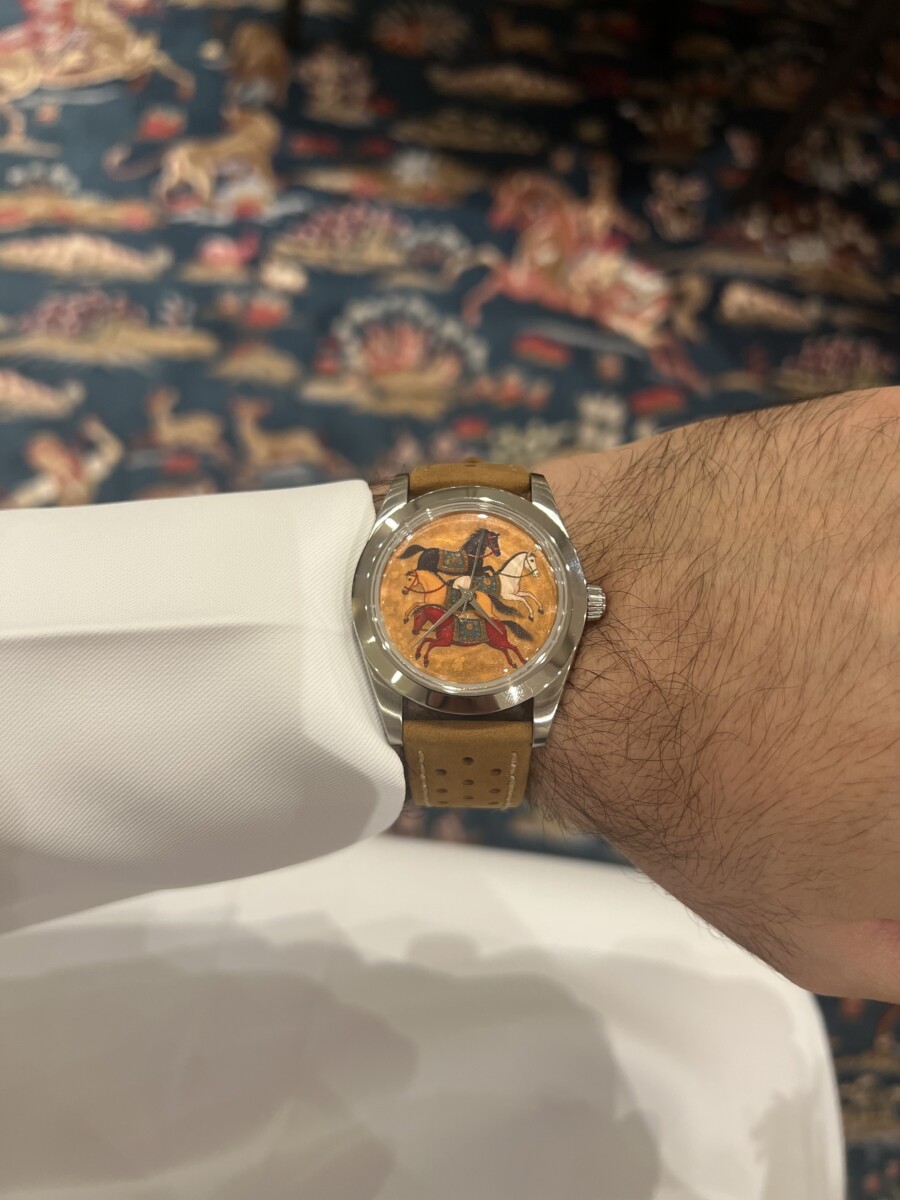

By definition, a Pièce Unique or Unique piece is a “Watch produced in a single example, usually created on commission or for special events.”
So when Dr. Abdulaziz first sent me a photo of his Pièce Unique in his hand: A warm, amber dial with four horses frozen mid-stride, I felt the same thing I get when a good story starts to rearrange itself in my head.
I know enough about watchmaking to recognise a thoughtful execution: 38mm, 9mm thick, domed sapphire, an NH35 automatic inside, the sort of compact, honest package that lets a dial do the talking. But I didn’t yet know the whole story behind the art on that face, or how that art had grown from friendship into a little business of feeling and craft.
Arnaud, the maker behind L’Artisan d’Horlogerie, is precisely the kind of person who makes that possible. His Instagram and site show what he’s been quietly obsessed with for years: stone and fossil dials, tiny landscapes, and textures cut from geological time. You’ll see dinosaur-bone slices, lapis, tiger eye, and other unusual materials rendered into round micro-portraits for the wrist. It’s all there in his online presence: process reels, close-ups of banded stone, and the occasional prototype coming to life.
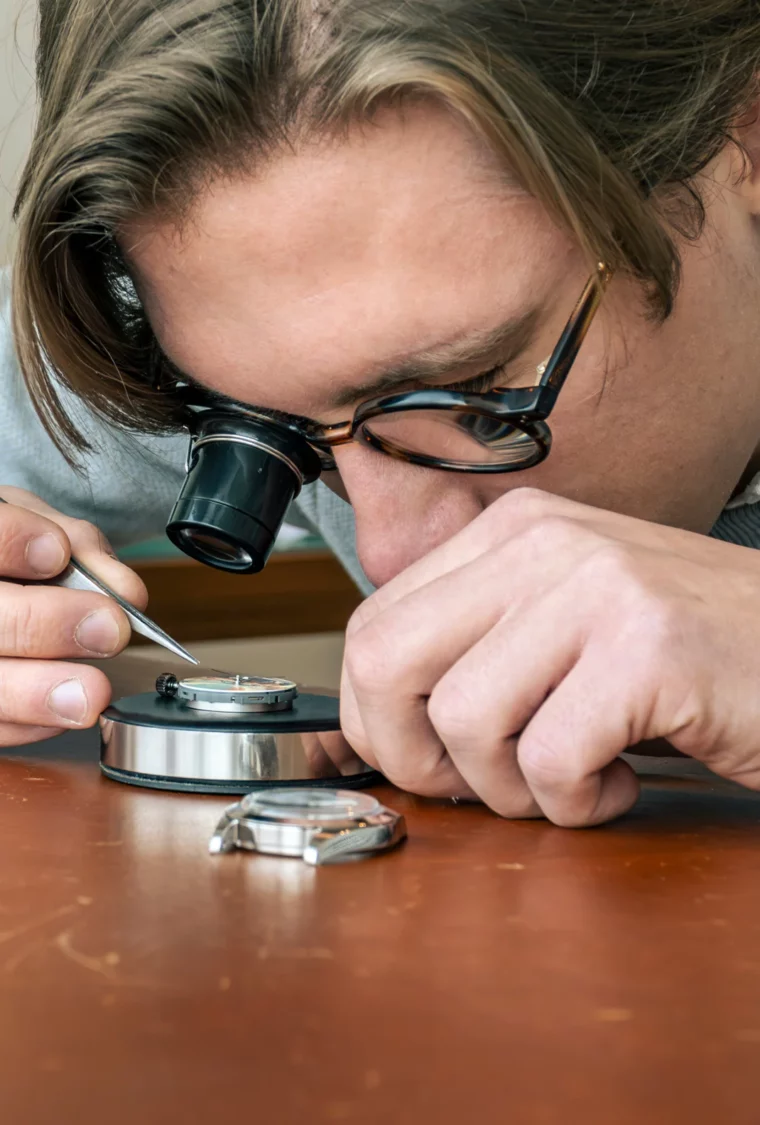
That’s the practical side. The thing that actually hooked Abdulaziz, and kept me listening to their story, was the personal. When they spoke about the two watches they made together, they weren’t riffing on lume or bevel angles. They were talking about family, memory, and a visual language that tied someone to a place. One of the two dials is this horse tableau on an amber field, warm, primitive, and somehow ceremonial. The other is a cooler, vivid composition: a blue field with three horses in the foreground, a building in the background, and a cluster of palm-like forms that read like memory and geography layered in paint.
Arnaud made both dials by hand, starting from sketches and material hunts. The materials matter: Arnaud’s work has always been about finding unusual raw things and coaxing them into wearable art, dinosaur bone, and tiger-iron pieces that are fragile, wasteful to cut, and breathtaking when they survive the process. The result is always a one-off or a tiny run. That’s the point: they’re intimate, uneven, and irreplaceable. You can see this aesthetic across his feeds and shop; the stone dials are the signature.
Abdulaziz’s two watches are a study in contrast and complement. The amber-hued dial reads like an heirloom: ochres and rusts arranged into silhouettes of four horses that could be carved out of a textile or painted on a fresco. It sits inside a compact, conservative case, 38mm across, 9mm thin, topped with a domed sapphire crystal, which keeps the drama on the face where it belongs. The movement is the NH35, a practical, reliable automatic chosen because the case couldn’t accommodate Arnaud’s newer, slimmer micro-rotor ideas; it keeps the piece honest and wearable, a little utilitarian so that the dial’s voice is never competing with technical showmanship.
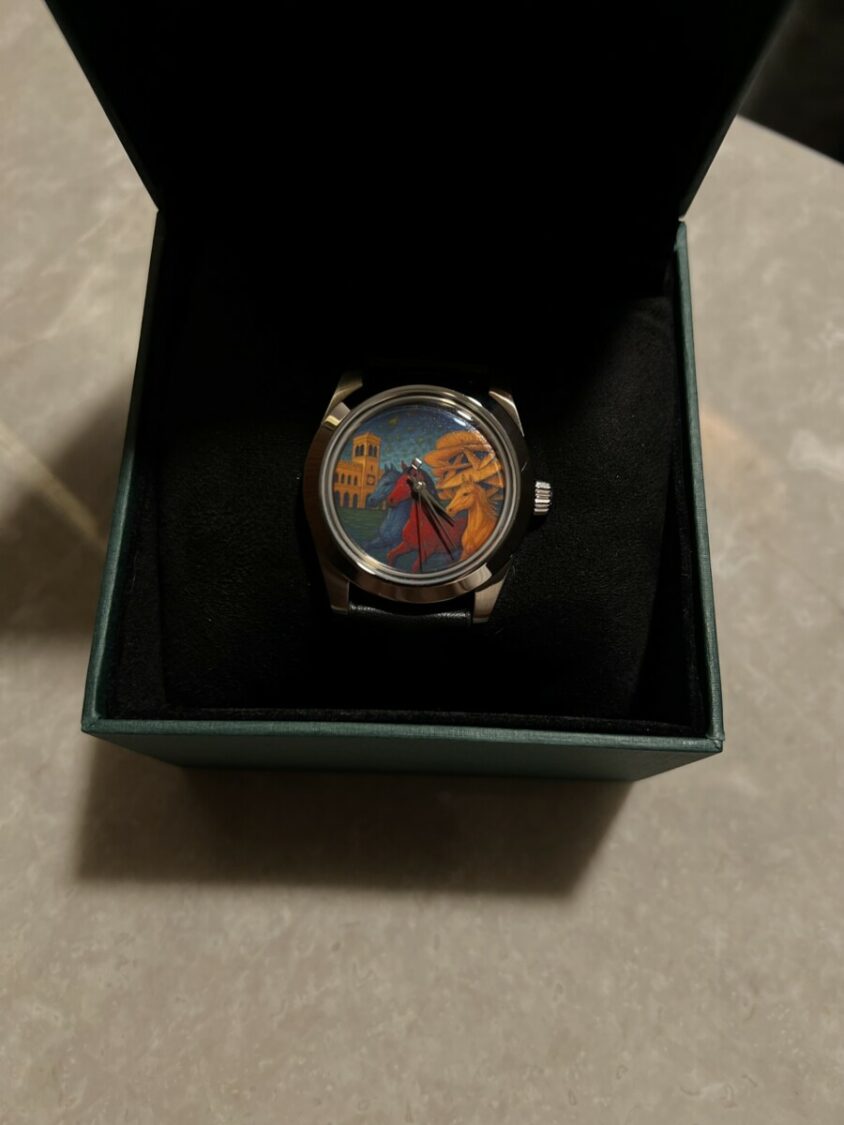
The second dial is story-driven in a way that the first one only hints at. Here, there are three horses again, but their colours are saturated: a red, a blue, and a golden figure, placed in front of an architectural element and a palm or floral motif that reads like a cultural emblem. In their conversations, Abdulaziz explained how the four horses motif, which appears in other parts of the project’s design universe, ties back to family roles and cultural identity: four siblings, different personalities, a shared set of values; the national museum and the desert; a grandfather’s shop and a father’s memory. These are visuals that mean something, not just pretty pictures. They’re personal heraldry translated into tiny, circular paintings on stone. Those ideas are in the audio: the dials are cultural maps, and the watches are the vehicles carrying them. (You can see photos that Abdulaziz shared; his images make clear there are two distinct designs, each treated with care and storytelling intent.)
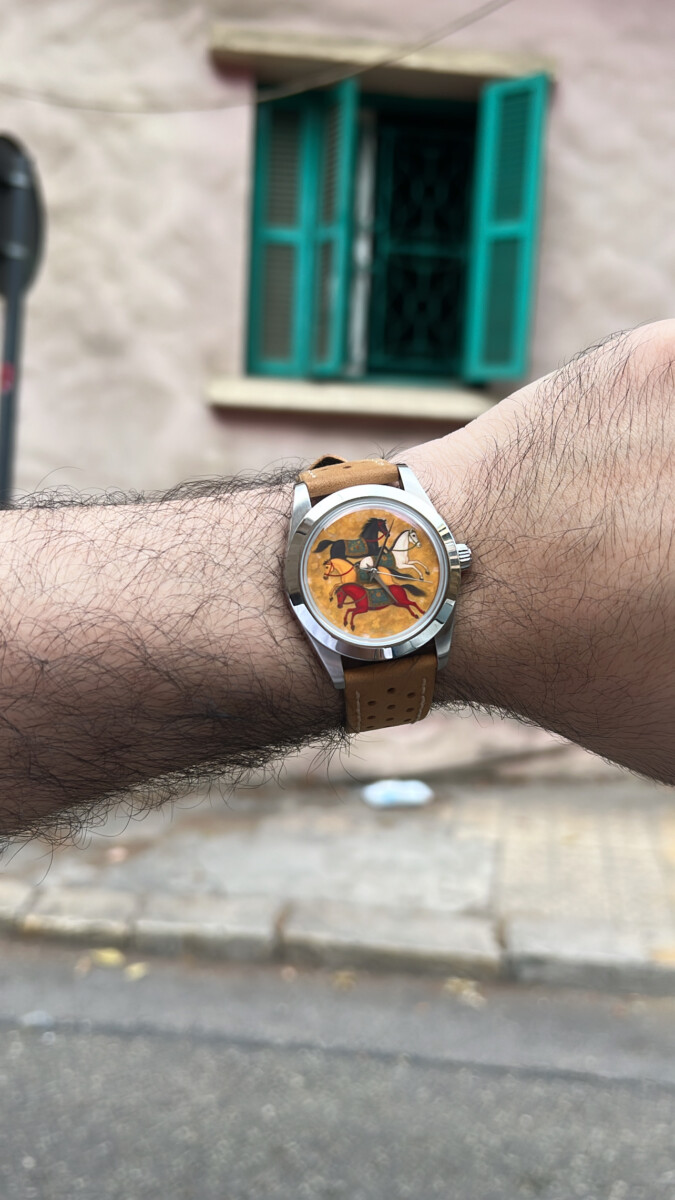
What I find compelling is how the technical choices bow to that storytelling. Arnaud could have chosen to over-engineer: exotic movements, showy cases, impossible finishing. Instead, he deliberately used a modest case profile and a dependable NH35 movement for Abdulaziz’s piece, leaving the dial to become the centre of attention. That decision, simplicity in service of meaning, says as much about the maker as the imagery itself. Arnaud’s Instagram and site show this pattern: craft that elevates unusual materials without overcomplicating the watch’s practicality.
There is another layer: how the friendship shaped the object. This began as friends riffing on ideas, not as a commission with a spec sheet. Abdulaziz didn’t walk in and demand a logo or a trend-driven hue; he brought memory, symbols and a trust that allowed Arnaud to interpret. In the studio the conversations became sketches, then scaled maquettes, then dial slices cut and polished until the images held the weight of the story. Arnaud told me about the losses in the cutting process (especially with fossils and delicate stones) and the way each success felt like a small miracle. He’s an obsessive with a craftsman’s patience, the kind of guy who will cut three different rough stones just to find the one that carries the exact red or banding he wants.
And there was beauty in their process: Abdulaziz’s cultural references, the museum’s architecture, the family horses, the desert colours, found a gentle interpreter in Arnaud’s hands. The watches became portraits of a friendship that had already started to move into business, a slow pivot from collectors’ chat to a real, collaborative practice. That transition felt natural because both men value the same rare thing: honesty. They were not trying to make a marketable halo piece. They were trying to make something honest for both of them.
There’s a practical lesson here, too: independent watchmaking is not only about inventing a movement or photogenic numerals. It’s about translating life into objects. One of the watches uses a humble, robust NH35 inside a compact 9mm-thick case with a domed sapphire, choices that ensure daily wear without compromising the soul of the design. The other dial speaks through imagery and colour, architecture, horses, personal iconography, and the watch becomes a conversation starter rather than a billboard.
If you look at Arnaud’s social footprint, you’ll see how this work fits a broader practice. L’Artisan is already known for stone dials and tiny series that sing because they are rare and tactile. The pieces for Abdulaziz sit comfortably in that lineage: singular, narrative-driven, slightly eccentric in the best way.
I’ve always thought the best collaborations are friendships that have learned to work together. This one feels that way: a collector and a maker who learned each other’s languages, who let small practicalities (case size, movement choice) bend to a larger aesthetic conversation, and who let cultural memory sit at the centre of the watch. When Abdulaziz wears the amber dial, you see something more than a timekeeper on his wrist; you see a small, wearable archive of family, time, and place. When he shows the blue, populated dial in its box, it reads as a miniature mural, a story paused in a second.
In a world that applauds shouty limited editions and technical flexes, making yours represents another type of horological superiority. They’re the sort of pieces that age in meaning, not just in patina. They are the product of a friendship that grew into a practice, and when the maker posts the cutting process on Instagram, or when Abdulaziz shares a wrist shot in a white thobe, you feel the lineage: two people making time into something that actually says something.
If you want to see the work yourself, Arnaud’s posts are a living sketchbook: raw stones, rehearsal sketches, and slow reveals of dials that survived the cut. But here’s the thing I keep thinking about: you don’t need to scroll to understand why this matters.
SUBSCRIBE NOW AND NEVER MISS A THING !

